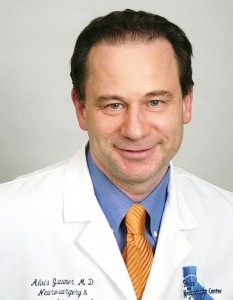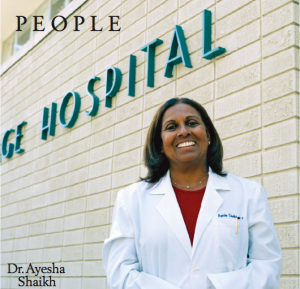Strokes can be paralyzing and debilitating: There are 4.5 million strokes every year in the United States, making them the third leading cause of death and the number one cause of disability. But thanks to the addition of a new Neurovascular Center at Cottage Hospital, under the leadership of Dr. Alois Zauner, swift and less invasive treatment for strokes and other brain illnesses is now available right here in Santa Barbara.
Leslie Dinaberg: Tell me about the new Neurovascular Center at Cottage Hospital?
Alois Zauner: The idea is really to build up a Neuroscience Center. The first aspect was really the most difficult, to build the neurovascular service. It is like trauma service, your head injury needs to be treated right away and the same for stroke. …
The problem for this region is that centers are in Los Angeles (UCLA or USC or Cedars) and then the next places are in San Francisco (UCSF or Stanford) and basically for 500 miles there is nothing. … So frequently in the past a patient, let’s say in Ventura or Oxnard, has a bleeding aneurism or a stroke, and does not get on time to UCLA or some other place.
The idea is really to build, in partnership with other hospitals, a Neurovascular Center for this region, not just for Santa Barbara. …And also help some other hospitals to provide service, because not everybody has to come here. Some stroke patients can be treated in smaller hospitals.
LD: Is it more about having the doctors with the skills to perform those surgeries or is it also about having the equipment?
AZ: It’s kind of both. The key issue is that it’s the upfront investment in what is called a Neuro-angiography suite and also … the material we use is very expensive. So you need to have a certain infrastructure and tools to really do it and then you need the ICU critical care units. It takes quite a lot of infrastructure…Building the new hospital some of the focus is on the neurosciences and the neurovascular unit is the first major step towards that direction. We already do spine surgery, there is neurology here, but some other programs will be new. There will be treatment for Parkinson’s and we’ll do brain tumors and also child development and things like that.
LD: That’s interesting.
AZ: …One reason for me to come here me is also a closer collaboration with USCB, especially the neuroscience research institute.
LD: So they have a research institute even though they don’t have a medical school?
AZ: Yes, UCSB has a neuroscience research institute and they do have very fine engineering and a lot of what they’re working on is related to pre-clinical science. …We’re doing the fundraising right now. …
LD: Did the hospital have this vision and then go out and find you to run the center or did you come in with a vision and they’re now creating the center?
AZ: Very good questions. I think when I was a fellow at UCLA there was always the talk that Santa Barbara was unserved … that a lot of the patients don’t make it on time to the right place when they had a stroke… Then I think Cottage had a consulting company, … (they were making) a major investment and had to be sure that they were targeting what’s needed for this region. So they were told neurosciences and then somehow I got involved.
I think the initial vision of Cottage was more to have a stroke center, but you know I think it merges more with what neurosurgeons do; you cannot just have a stroke center because you have strokes but also the aneurisms … and a full spectrum of vascular diseases.
LD: It makes sense with our aging population.
AZ: Yes, in town but also everywhere, it’s not just for Santa Barbara, it’s for this region…One of things we’re doing is using a Robot in the ER and they can communicate with the people here. The Robots are made by a company here in SB called InTouch Health (www.intouchhealth.com), we have them here in the ICU … right now we have this at home, but the idea is that we’re partnering with other hospitals so they will have this in emergency rooms and assist the physicians who is not expert in say neuro, and discuss the films and can ask the patient questions and we can then decide how to treat them. … Critical care is also very important and I’ve spent a lot of time the last six months to work with the nurses and technicians because we do so much more to monitor the brain so that’s very important.
LD: How far away is the center from completion?
AZ: The neurovascular is in place, basically, but I think that the neuroscience center, that will take a while. …
LD: Can you explain the new minimally invasive techniques you are using?
AZ: A traditional way to treat an aneurism is do open surgery. So you do a craniotomy (where you surgically open the skull) and we go into your brain… we still do about 15-20% like that because the minimally invasive technology with the things we have right now we cannot do 100%, maybe 85%. In the case of neuroendovascular surgery a tiny little catheter goes into the brain…and we pull out the clot.
LD: In addition to being less invasive is there less chance of other complications?
AZ: … Less invasive does not mean that there’s less risk. Yes there’s less pain involved, they get to go home much quicker, the ICU care is much easier, like the aneurism we had today can go home in a few days. So yes, patients have less pain but it’s not always less risks.
LD: Is there a specific person that you’re working with at UCSB to make all this happen?
AZ: Matthew Tirrell is the Dean of Engineering. I think he’s the person who is really the key.
LD: Why did you choose to come to Santa Barbara to build this center?
AZ: What I wish is that we really can build this up, that we make a difference in the community. …It’s also I think very important for us to really be connected to UCSB to develop a center, because really what we do is so new that I think you cannot completely separate it from research or new ideas and I do hope that in a smaller hospital we can also work with researchers. It’s easier than in a big medical facility.
Vital Stats: Dr. Alois Zauner
Born: Austria
Family: Wife Teresa, son Alexander, age 10 (“they’ve only been here six weeks)
Professional Accomplishments: Medical degree from the University of Vienna; surgical internship and neurosurgical residency training at the Medical College of Virginia; combined fellowship in neuroendovascular surgery and diagnostic and interventional Radiology at UCLA; one of only 50 Neurosurgeons in the U.S. with training in neurointerventional radiology and endovascular techniques; director of Neuroendovascular Services at the University of Miami in Florida, and Assistant Professor in the Department of Neurological Surgery and Radiology; working to establish a new Neurovascular Center at Santa Barbara Cottage Hospital.
Little-Known Fact: “My family would like to have me back in Austria.”


